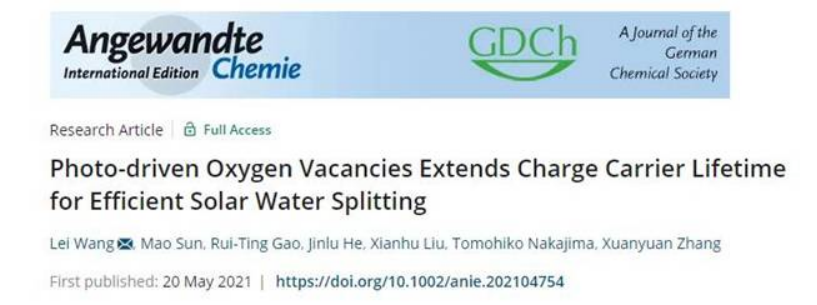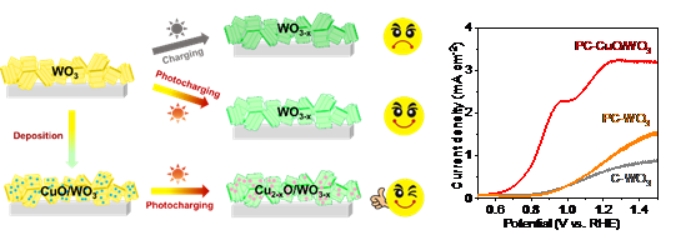The project team headed by Prof. Wang Lei of the College of Chemistry and Chemical Engineering of IMU have recently achieved new progress in the research of photo-driven charge separation of semiconductors, which was announced by their thesis published in Angew. Chem. Int. Ed. entitled Photo-driven Oxygen Vacancies Extends Charge Lifetime for Efficient Solar Water Splitting (URL: https://onlinelibrary.wiley.com/doi/10.1002/anie.202104754), with IMU as the first author and correspondence author organization, Sun Mao, a postgraduate student of IMU enrolled in 2019 as the first author, Prof. Wang Lei and Research Fellow He Jinlu of the College of Chemistry and Chemical Engineering of IMU and Research Fellow Tomohiko Nakajima of the National Institute of Advanced Industrial Science and Technology of Japan as corresponding authors.

Production of hydrogen through photo-driven water splitting is one of the effective means for green production of hydrogen energy. Given the band gap of 2.7eV, the WO3 semiconductor is an ideal visible photo-driven material. However, the combination of photo-driven carriers of semiconductors severely hampers the efficiency of photo-driven production of hydrogen. Studies in recent years have reported the high capacity of WO3 photoelectrode with oxygen vacancies in water oxidation and the properties of the existence of oxygen vacancies in significantly improving the conductivity of WO3 photoelectrode, band structure and the absorption of surface molecules. However, as a deficiency, oxygen vacancies, when excessive, will be converted into centers of combination of carriers, which will shorten the lifespan of the transmission of carriers and lead to recombination of the semiconductor/electrolyte interface, thus severely lowering the efficiency in the production of hydrogen. In most cases re-treatment (H2-O3; H2-O2) is adopted to fill the excessive surface oxygen vacancies. The project team headed by Prof. Wang Lei have recently publicized for the first time the strategy of charging/discharging by photo-electric coordination to activate WO3 photoelectrodes, contain the combination of carriers and subsequently improve the photo-electric catalytic performance significantly. The 8-10 nm of amorphous layer and oxygen vacancies on the surface of semiconductors activated by photo-electric coordination ensure 25 consecutive cycles and approximate the endurance of 50 h. With further construction of WO3/CuO heterojunction, the semiconductors activated by photo-electric coordination acquire photo-electric current response of 3.2 mA cm-2 under the electric potential of 1.23 VRHE. The simulation theory of non-adiabatic molecular dynamics calculated through density functional theory confirms that the strategy of coordinated photo-electric activation can effectively prolong the lifespan of WO3 carriers. The finding offers a new strategy and perspective for addressing excessive oxygen vacancies and is universally applicable for other semiconductors (Fe2O3, TiO2, etc).

The project was sponsored by the National Natural Science Foundation of China (51802320, 21965024), the Plan of Introducing Talents by Subject Innovation in Colleges and Universities (D20033), the Science Fund for Distinguished Young Scholars of Inner Mongolia (2020JQ01) and IMU Startup Fund for Introducing Talents (21300-5195102).
The corresponding author: Wang Lei, professor of the College of Chemistry and Chemical Engineering, PhD Supervisor, working independently at the College of Chemistry and Chemical Engineering of IMU since December 2018, selected into the Grassland Talents Program and the Outstanding Youths Program of Inner Mongolia Autonomous Region. Since their founding in January 2019, the research team have published 12 SCI theses with IMU as the first organization in journals including Angew. Chem. Int. Ed. (3theses), ACSCatal., Appl. Catal. B,J. Mater. Chem. A (6 theses) and ACS Appl. Mater. Interface, with the average factor of 12.
Homepage of the project team: https://www.x-mol.com/groups/imu_wanglei

